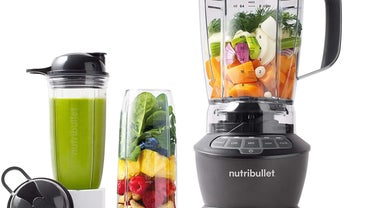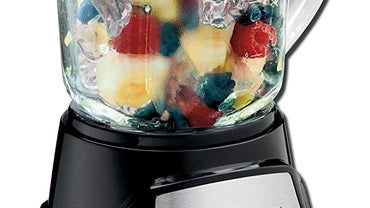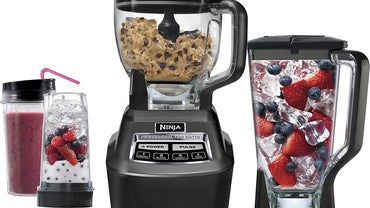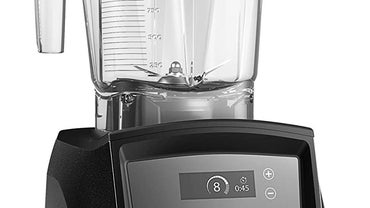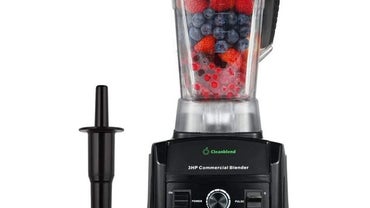When people think of blenders, the first thing that typically comes to mind is making icy drinks or smoothies. However, a quality blender can do more than make margaritas — it can be a powerful kitchen helper. You can use it to blend or puree soup, make dips and even chop up vegetables (with the right attachment).
Shopping for a blender can be overwhelming. There are hundreds of blenders available at every price point and design style. How do you choose? Start with the blender’s speed options. The more speed, the more versatility you’ll get out of the blender. You’ll want one with at least three speeds — one for ice, a lower speed for mixing or pureeing delicate foods and a higher speed for everything else. The blender’s power will also come into play. You may be able to get by with 500 watts if all you’re using the blender for is smoothies. However, the higher the watts, the more you can blend, puree and mix without the appliance overheating.
When looking at blenders, don’t forget capacity. Some are small, holding a couple of cups, and go up to as much as 14 cups in capacity. It all depends on how much you’ll be blending at a time and the amount of space you have available on your kitchen counter. We looked at dozens of models to bring you some of the best blenders that meet these criteria and more.
This guide narrows the selection down to a few of the best available to help you choose.
Specs:
1200W
3 speeds
Up to 64 ounces
BPA-free high performance plastic pitcher
16.97″ high overall
Comes with base, blender pitcher with lid and vented lid cap, 32oz cup, 24oz cup, to-go lids, easy-twist extractor blade and recipe book
Nutribullet’s blender combo comes with a couple of personal cup attachments that make it possible to make blended drinks, smoothies or soups for one person using the 32oz or 24oz cups — or several when you use the 64oz pitcher. You can always buy more single-serve cups if you’d like to make multiple personal drinks.
It’s powerful — the 1200W motor can handle most of what you throw at it. There are five settings, including extract, low, medium, high and pulse, so you can adjust power and speeds according to what you’re blending. Best of all, the durable plastic pitcher is BPA-free and easy to clean. The extractor-blade base unscrews for handwashing, and the pitchers are dishwasher safe.
Pros:
Cons:
Specs:
Hamilton Beach’s blender is the most affordable of the blenders reviewed. It’s ideal for anyone starting out and on a budget. Just because the price is low doesn’t mean you’re missing out. The motor’s 700W is capable of crushing ice without too much trouble. And unlike some more expensive blenders with plastic pitchers, the Hamilton Beach comes with a durable glass 40oz pitcher.
The blades create a wave action that helps draw foods down easier without an excessive need for liquids. This could save you from having to tap to get air pockets out or by having to push ingredients down with a spoon. Plus, you have 12 blending functions shared by five easy-to-read buttons for an uncluttered look.
Pros:
Cons:
Also a food processor
Specs:
1500W
4 speeds
Up to 72oz
BPA-free plastic pitcher
17.75″ high overall
It comes with a base, a pitcher with lid and vented lid cap, food processor bowl, dough blade, cleaning brush and two Ninja cups with to-go lids.
The Ninja BL770 is the most featured blender in our roundup. Blend large quantities in the 72oz hard plastic pitcher, create personal smoothies in the two included Ninja cups or add the food processor attachment to mix dough, chop, dice or slice. Ninja claims you can make two pounds of dough in just 30 seconds using the food processing bowl and dough blade.
This kitchen system is a great way to reduce the number of appliances that take up real estate on your kitchen counter. However, you’ll still need storage to keep the various attachments organized.
Cleanup is fairly easy after use. The components are dishwasher safe and BPA-free, so you don’t have to worry about harmful chemicals in your servings. Although you can throw the items in the dishwasher, Ninja recommends you handwash as many of the parts as possible in warm, soapy water using the cleaning brush.
Pros:
It’s a blender, personal smoothie maker, food processor and dough mixer in one.
Great price for what you get
Powerful, 1500W motor can crush ice in seconds
Two personal drink cups include to-go lids for ease
Dishwasher safe
Cons:
Plastic pitcher (instead of glass)
It comes with several parts, requiring organization and storage
Specs:
Up to 2.2 peak horsepower
Pulse setting plus turn dial for adjustable speeds
Up to 64oz
Plastic low-profile pitcher
17″ high overall
It comes with a base, blending container with lid and cookbook.
No review of best blenders can be complete without mentioning Vitamix. It’s an industry leader in professional-grade blenders for individuals who want the best. Vitamix blenders do things a bit differently. The company doesn’t tout wattage or speeds. You’ll find that the blenders come with motors that have a peak horsepower of 2.0 or 2.2. It could be equated to as much as 1,400W. As for speeds, a turn dial allows you to fine tune blending according to your needs.
Adding to why this blender is one of the best is its smart home connectivity. You may be wondering why anyone would want a smart blender. After all, blenders are meant to be simple — put food in the pitcher and hit a button to blend. The programmable timer ensures you don’t over or under-mix your ingredients so you can carry on with other tasks in the kitchen. Plus, the base can recognize the size of your container (if you choose to purchase a smaller pitcher or personal blender cups) to adjust the settings and blend times.
Pros:
Expandable when you purchase additional containers of different sizes
Great for making soup — heats container items in six minutes as they blend
Download the Vitamix perfect blend app to add 17 programs and over 500 recipes.
Digital touchscreen
The dial lets you fine tune your speed
Cons:
Affordable professional blender
Specs:
1800W
Variable-speed knob
Up to 64oz
BPA-free plastic pitcher
18″ high overall
It comes with a base, a pitcher with a lid and a tamper
The Cleanblend commercial blender got its fame for its unique and powerful eight-blades. So much so that people were throwing household objects into the pitcher to find what exactly it can’t blend. In fact, Cleanblend added a disclaimer asking people not to blend their smartphones. It’s safe to say the Cleanblend can handle almost everything effortlessly.
The soup feature is popular. Throw in your vegetables and run the blender. After a few minutes, the blades develop enough friction to heat what you’re blending, creating a hot soup or puree that can be served right from the pitcher. In fact, Cleanblend has recently updated the model by adding a rubber handle to the pitcher to account for the heat the blender is capable of producing if you run it in heat mode.
Pros:
8-blades can quickly process nearly any ingredient
Commercial blender crushes, blends, grinds, chops, processes, liquifies and can also heat foods
Powerful 1800W motor
Tamper can integrate into the lid so you can move food around while it’s operating without spills
Cons:
Higher price point
No extra attachments
How did we choose these products?
To choose the best blenders reviewed, we looked at the specs and construction. We don’t have access to a home lab to try out dozens of blenders, and you probably don’t either. Therefore, certain criteria can help you determine what the best blender available could be.
Some of the factors we used to choose the best blender included:
Watts: A good measure of the blender’s power. Blenders of at least 500W were compared.
Speeds: The more speeds, the more versatile the blender can be. We chose blenders that had at least three speeds.
Design: How attractive would the blender be in a home setting, and is it timeless enough to work with nearly any kitchen style?
Size: We provided a variety of blender capacities to work in all kitchen sizes and for multiple servings.
Cleaning: Being able to clean your blender by disassembling the base easily is helpful. Components that are dishwasher safe are the most ideal.
Attachments: Blenders that come with special attachments provide the utmost flexibility to expand the appliance’s use.
Price: Professional models are typically the most expensive. We chose models that provided value for the price.
Customer reviews: Don’t dismiss what others who have purchased a model have to say. Customer reviews can reveal benefits and drawbacks regarding the blender you’re interested in that you may not be able to see simply from reviewing photos and specs.
Which is the right one for you?
When deciding which blender is right for you, start with deciding on how often you’ll use it and for what. If it’s a daily-use tool for making morning smoothies, a smaller, lower-watt blender with a personal cup attachment may be ideal for making smoothies to go. If you plan on crushing ice, choose a heavier-duty blender that’s higher wattage and has an ice or crush setting.
If you use your blender regularly, take a good look at its construction for clues about durability. Professional-grade blenders feature metal or heavy-duty plastic components, which will last longer. A glass receptacle is the best. And as far as ease of cleaning the blender container, look for one that can be easily taken apart for cleaning.
Best blender FAQ
What’s the difference between a blender and a juicer?
Blenders and juicers work differently. Blenders can mix anything you insert. The blades at the bottom will chop up and mix the foods. In contrast, a juicer separates parts of the fruit or vegetable from the liquid, and the extract will pour into a glass or container. Blenders are great for making smoothies, soups and purees. Juicers are designed to extract the juice from most fruits, herbs, and vegetables, separating the non-liquid parts such as the pulp so that you can dispose of it.
How many watts do you need for a blender?
For most basic uses, such as making a smoothie or pureeing, you could probably get a 500W to 750W blender. For heavier-duty use, such as making frozen mixed drinks, a professional-grade blender of 1,200W to 1,500W is best.
Are all blenders really loud?
Regardless of the tech advances available, all blenders are pretty loud. It’s the way they’re built. You’ve got a glass or metal container with high-speed blades that spin to finely chop items up. Even if the blender itself is relatively quiet when it’s running, items such as ice, nuts or hard foods will make lots of noise as they get pulverized. You may be able to somewhat dampen the sound by placing a towel over the blender.
Are there alternatives worth considering?
Blenders are useful but can be a hassle to clean. Depending on what type of mixing you mostly do, you may be able to skip the blender completely and replace it with a different type of small kitchen tool or appliance.
Some alternatives include:
Immersion blenders: These blenders are handheld sticks that you can plug in and drop into an existing glass, container and even a warm pot or pan. They make mixing far easier since you can blend right in the spot you’re serving from or cooking in. They’re also easier to clean since all they need is a quick immersion in some warm soapy water and a rinse. However, immersion blenders don’t do a great job at chopping. They’re best for mixing and pureeing.
Handheld mixers: Handheld mixers have two or more rotary whisks that can mix or beat foods effortlessly. Like immersion mixers, they can be used in a variety of different bowls and containers and are easy to clean. They fall short when it comes to purees since the whisks can’t chop as effectively as a blender or immersion mixer.
Food processors: If you’d like a single kitchen tool that can handle almost everything, a food processor may be the answer. They typically come with a variety of attachments that make slicing, dicing, chopping, pureeing and more possible. Food processors are typically more expensive than a blender, but they may be more versatile, as well.
